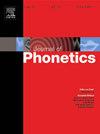Thai speakers time lexical tones to supralaryngeal articulatory events
IF 2.4
1区 文学
0 LANGUAGE & LINGUISTICS
引用次数: 0
Abstract
What do speakers do when they produce tones? Do they aim for the synchronization of f0 targets with segmental acoustic events, or do they execute a routine in which f0 changes and oral articulations are precisely coordinated? This paper explores these questions in Thai using acoustic and electromagnetic articulography data from eight speakers. Drawing on analyses of variability, stability, and informativity, our findings indicate that the timing of the onsets of tonal and oral articulatory gestures is generally more stable than the timing of tonal and oral targets, both in articulatory and acoustic measurements. When comparing the two modalities directly, we found that the lag between tonal onset and vocalic gesture onset exhibits the lowest variability and the highest mutual information among a large set of timing measures. Additionally, only articulatory lags remain stable under rate and context perturbations. To explain these findings, we propose that Thai tones are timed onset-to-onset with vocalic gestures and develop a model that formally implements this proposal. This model also accounts for otherwise puzzling acoustic patterns, such as a negative lag between tonal onset and acoustic syllable boundaries at slower speech rates. Further temporal patterns, such as surface non-zero time-locking rather than perfect synchrony of events, are also clarified. In sum, this work advances our understanding of tonal timing in Thai and outlines its implications for more general theories of phonology and speech production.
泰语使用者根据咽上发音事件来确定词汇音调的时间
当说话者发出音调时,他们会做什么?他们的目标是将f0个目标与分段声学事件同步,还是他们执行一个常规,其中f0个变化和口头发音精确协调?本文利用来自八位说话者的声学和电磁发音数据在泰语中探讨这些问题。通过对变异性、稳定性和信息性的分析,我们的研究结果表明,在发音和声学测量中,声调和口头发音手势的开始时间通常比声调和口头目标的开始时间更稳定。当直接比较这两种模式时,我们发现音调开始和语音手势开始之间的滞后在大量的时间测量中表现出最低的变异性和最高的互信息。此外,只有发音滞后在速率和上下文扰动下保持稳定。为了解释这些发现,我们提出泰语音调是与语音手势同步开始的,并开发了一个正式实施这一建议的模型。这个模型也解释了其他令人费解的声学模式,比如在较慢的语速下音调开始和声学音节边界之间的负滞后。进一步的时间模式,如表面非零时间锁定而不是事件的完美同步,也被澄清。总之,这项工作促进了我们对泰语音调时序的理解,并概述了其对音韵学和语音产生的更一般理论的影响。
本文章由计算机程序翻译,如有差异,请以英文原文为准。
求助全文
约1分钟内获得全文
求助全文
来源期刊

Journal of Phonetics
Multiple-
CiteScore
3.50
自引率
26.30%
发文量
49
期刊介绍:
The Journal of Phonetics publishes papers of an experimental or theoretical nature that deal with phonetic aspects of language and linguistic communication processes. Papers dealing with technological and/or pathological topics, or papers of an interdisciplinary nature are also suitable, provided that linguistic-phonetic principles underlie the work reported. Regular articles, review articles, and letters to the editor are published. Themed issues are also published, devoted entirely to a specific subject of interest within the field of phonetics.
 求助内容:
求助内容: 应助结果提醒方式:
应助结果提醒方式:


